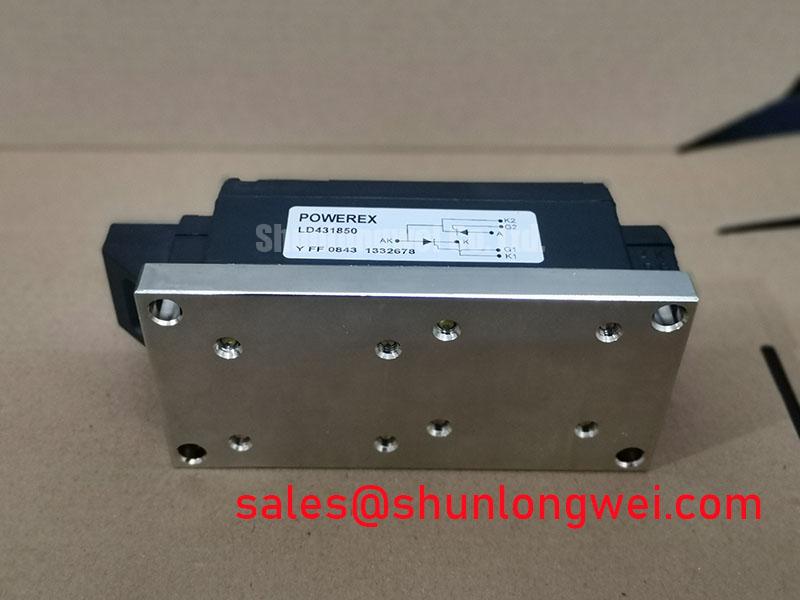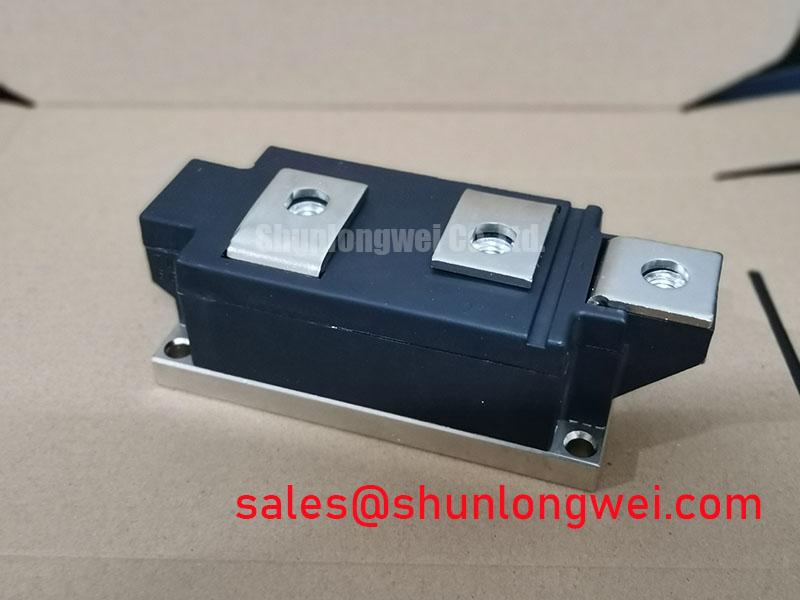Content last revised on November 21, 2025
LD431850 | Powerex 1800V 500A Dual SCR Module for High-Reliability Phase Control
Product Overview
Engineered for Durability in High-Stress Power Applications
The Powerex LD431850 is a high-performance POW-R-BLOK™ dual SCR isolated module, meticulously designed for superior reliability in demanding industrial phase control systems. It combines a robust 1800V | 500A | 17,000A ITSM electrical specification with an advanced compression-bonded construction. This design approach delivers two critical engineering benefits: enhanced operational lifetime and simplified thermal design. By eliminating solder fatigue points, the LD431850 provides a predictable and durable solution for controlling high-power loads in applications like industrial motor drives and controlled rectifiers. For high-power controlled rectifiers and industrial motor soft starters requiring maximum surge survivability, the LD431850's 17kA ITSM rating makes it a definitive choice.
Application Scenarios & Value
System-Level Benefits in Industrial Motor Control and Power Conversion
The LD431850 excels in environments where electrical robustness and long-term reliability are non-negotiable. Its primary value is demonstrated in high-power AC and DC motor control, particularly in applications such as industrial soft starters. The engineering challenge in these systems is managing the immense inrush current during the startup of large, multi-horsepower motors. The LD431850's exceptional peak surge current rating of 17,000 Amperes directly addresses this, providing the necessary headroom to withstand these stressful events repeatedly without degradation. This capability ensures reliable equipment operation and prevents costly downtime.
Beyond motor control, this dual SCR module is an integral component for the front-end of high-power systems, including:
- Controlled Rectifiers: Forming the core of regulated high-current DC power supplies for industrial processes like electroplating and large-scale battery charging.
- Welding Power Supplies: Offering the precise and robust phase control needed to manage the high-current arcs in advanced welding systems.
- VFD Front-Ends: Serving as a reliable AC-DC rectification stage in large Variable Frequency Drives (VFDs), where its resilience to line fluctuations is critical.
What is the primary benefit of its compression-bonded design? Enhanced long-term reliability by eliminating solder fatigue. The module's architecture is fundamentally built to deliver consistent performance over a long operational life, reducing the total cost of ownership for the end equipment.
Technical Deep Dive
The Engineering Advantage of Compression Bonding for Long-Term Reliability
A key differentiator of the LD431850 is its use of a compression-bonded, solder-free design. In conventional power modules, the silicon die is soldered to a baseplate. Over time, the repeated heating and cooling of thermal cycles cause the solder and silicon—which expand at different rates—to develop micro-cracks, leading to increased thermal resistance and eventual device failure. The LD431850 circumvents this primary failure mode entirely.
The technology employs a pressure-contact system that maintains a constant, uniform force on the silicon element. This approach offers a clear engineering advantage. Think of a soldered connection like a rigid glue joint between wood and metal; repeated temperature changes will inevitably stress and break the bond. A compression-bonded design, however, is more like a perfectly torqued bolted connection with spring washers. It accommodates thermal expansion and contraction, maintaining impeccable electrical and thermal contact over millions of cycles. This results in significantly higher power cycling capability and a more predictable, reliable service life in applications with frequent load variations.
Key Parameter Overview
Decoding the Specs for Enhanced Thermal and Electrical Robustness
The specifications of the LD431850 are tailored for high-power industrial applications, emphasizing robustness and thermal efficiency. The values below are extracted from the official datasheet and represent the core performance metrics for system design.
| Parameter | Value |
| Repetitive Peak Forward & Reverse Blocking Voltage (VDRM, VRRM) | 1800 V |
| Average Forward Current (IT(AV)) @ TC=84°C | 500 A |
| RMS Forward Current (IT(RMS)) | 900 A |
| Peak One Cycle Surge Current (ITSM) @ 60Hz | 17,000 A |
| I²t for Fusing (8.3 ms) | 1.20 x 106 A²s |
| Operating Junction Temperature (TJ) | -40°C to +130°C |
| Thermal Resistance, Case-to-Sink (RθC-S) Lubricated, Per Module | 0.01 °C/W |
| Isolation Voltage (VISO) | 2500 VRMS |
Download the LD431850 datasheet for detailed specifications and performance curves.
Frequently Asked Questions (FAQ)
Design and Implementation Inquiries
How does the low case-to-sink thermal resistance of 0.01 °C/W impact heatsink design?
This extremely low thermal resistance signifies a highly efficient thermal path from the module's baseplate to the heatsink. For engineers, this translates directly to either a smaller, more cost-effective heatsink for a given power dissipation or lower operating junction temperatures with a standard heatsink. Lower junction temperatures are a cornerstone of improved system reliability and longer service life, as explored in guides on unlocking thermal performance.
What is the practical benefit of the 17,000A peak surge current (ITSM) rating?
This high surge rating provides a critical safety margin against fault conditions and high inrush currents. It allows the module to safely withstand the massive current spikes from motor startups, capacitor charging, or line-side faults without failure. This robustness can simplify protection circuitry and enhance the overall resilience of the end equipment.
What does "compression bonded" mean for the LD431850's long-term performance?
"Compression bonded" refers to a manufacturing technique that eliminates solder layers for the main electrical and thermal contacts. This directly mitigates solder fatigue, a primary wear-out mechanism in conventional modules. The result is a device with superior power cycling capability and a significantly more reliable operational lifespan, especially in applications with frequent temperature swings.
Is additional electrical insulation required when mounting the LD431850?
No. The LD431850 features an integrated Aluminum Nitride (AlN) isolator that provides 2500 VRMS of electrical isolation between the terminals and the metal baseplate. This allows the module to be mounted directly to a grounded heatsink without the need for external insulating pads (like mica or silicone), which simplifies assembly, reduces component count, and ensures a better thermal interface.
How does compression bonding improve reliability? It eliminates solder fatigue, a primary failure mode in power modules.
By integrating features that enhance both thermal performance and mechanical longevity, the LD431850 provides a strategic foundation for building industrial power systems that are not only powerful but are fundamentally more durable and cost-effective over their entire lifecycle.








